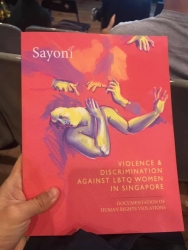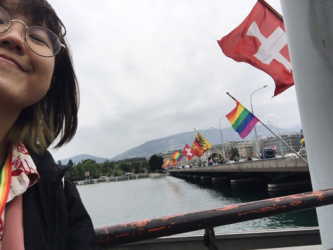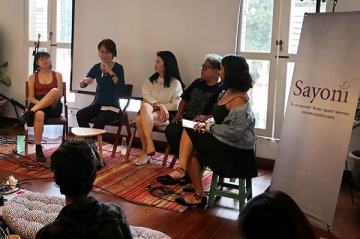As an intervention into our normative understanding of 'the real' and its accompanying politics of convention, this performance piece has numerous conceptual goals. The first is to assert that often, normative understandings of biological function are a mythology imposed on form. It is this mythology that creates the sexist, racist, ableist, nationalist and homophobic perspective, distinguishing what body parts are 'meant' to do from their physical capability. The myth that a certain set of functions are 'natural' (while all the other potential functions are 'unnatural') undermines that sense of capability, confining lifestyle choices to the bounds of normatively defined narratives.
Just as it is a myth that women are 'meant' to be feminine and men masculine, that penises and vaginas are 'meant' for penetrative heterosexual sex (or that mouths, anuses, breasts, feet or leather, silicone, vinyl, rubber, or metal implements are not 'meant' for sex at all), it is a myth that ovaries and a uterus are 'meant' to birth a child.
When considering my own bodily form, I recognize its potential as extending beyond its ability to participate in a normative function. While my organs are capable of engaging with the narrative of reproduction, the time-based linkage of discrete events from conception to birth, the realm of capability extends beyond the bounds of that specific narrative chain. These organs can do other things, can have other purposes, and it is the prerogative of every individual to acknowledge and explore this wide realm of capability. [Read the full article]
After reading her explanation, I kinda-maybe-perhaps got it. She is seeking to challenge the ideas societies have of the body, and what they are meant to do. People react to this art-piece not in the way she hopes them to, though. They focus more on the “abortions” themselves, and the way she chooses to put her point across. Curiously, both sides of the abortion debate seems more or less united in the condemnation of her methods. The pro-life camp is clearly against it, and the pro-choice camp has taken the stand that abortion/miscarriage is a serious matter, and it is not to be trivialised this way, a view I share. Most women take months, years to recover from a single abortion/miscarriage, beyond the physical issues. The blood loss, the stress that the human body goes through in an abortion/miscarriage is tremendous. To experience that multiple times in a row is simply unimaginable, which is part of why I think Shvarts never got pregnant at all, though the rest of it might have been true, the insemination, the ingestion of the herbal abortifacent, etc. If she did, I seriously hope she gets a doctor and a shrink.
But going back to her art – I get it when she says it, but not by reading about her actual artwork. Which, to me, suggests that she hasn’t done a very good job of conveying her central idea, because what is most visible to me is that she has put her body through a gruelling experience, and she is turning it into an artpiece.
The central idea that there have been normative definitions assigned to body parts, and this artpiece challenges that, does not occur to me. Also, her points about what body parts are “meant to do” strike home in the queer community. We are often told our sex is “unnatural”, that the only possible natural combination is the penis and vagina. I follow her up to that point, but her next point, that it is a myth that the ovaries and the uterus are “meant” to birth a child, makes me stop and wonder the logic is extensible.
I really wish she could have found some other way to do this, without harming her body. And more importantly, other people, because what I am most afraid of is that some woman somewhere is going to emulate this, and die trying or hurt herself really badly.
Which would really be completely untenable, if it turns out that this is a hoax, like Yale is claiming it is. And it is not even clear whether such a thing is medically feasible, as experts have now weighed in their opinions that there is no “safe” natural herbal abortifacent (which, all the more makes me worried about the harm to other women).
The drama has come to an end, at least in Yale – they have refused to display Shvart’s project at the opening. But the discourse that was generated is nowhere near its end, I am pretty sure. Shvarts will keep us talking for years to come.
Which, is what art is all about.




Comments
April 24, 2008 at 12:57 pm
Yes, I think she’s drawing too long a bow here too. Our hands, with opposable thumbs, evolved to give us better grasping ability. Of course they can be used for other things, including sexual stimulation and non-verbal communication (esp. in traffic jams!), but does this mean that the grasping ability of our hands is myth? The logic breaks down.
I am pro-choice, but this item has crossed the line, even for me. It also smacks me of cowardice. If she really had the conviction of an artist (and everything else be damned), why not, say, saw off one of her fingers each month? I could make up an equally strange justification regarding blood, the monthly frequency, bodily fluids seen (that is, out in the open) versus unseen, the significance of the difference between “other” bleeding (the fingers) and “feminine” bleeding (menstrual blood), and the social shame attached to one and not the other, not to mention a comparison of the pain involved and how it relates to cramps, birth, whatever. See? It’s not all that difficult. Maybe some Arts Council will give me a grant. ;) Of course, I’m loco; but at least I’m artistically loco with an arts grant, right?
My personal opinion is that she went for this purely for the shock value. It reminds me a bit of “Piss Christ”, in that regard. Initially provocative but ultimately shallow.
RSS feed for comments to this post